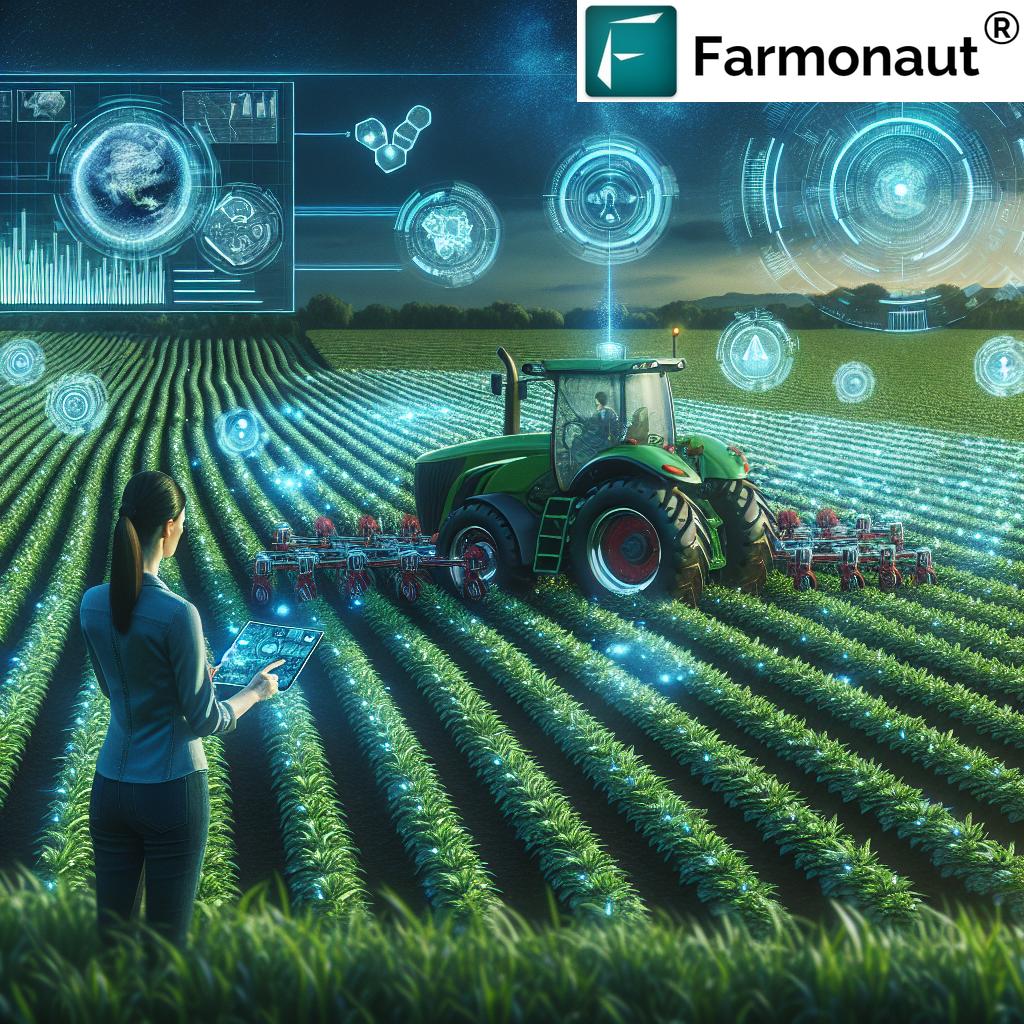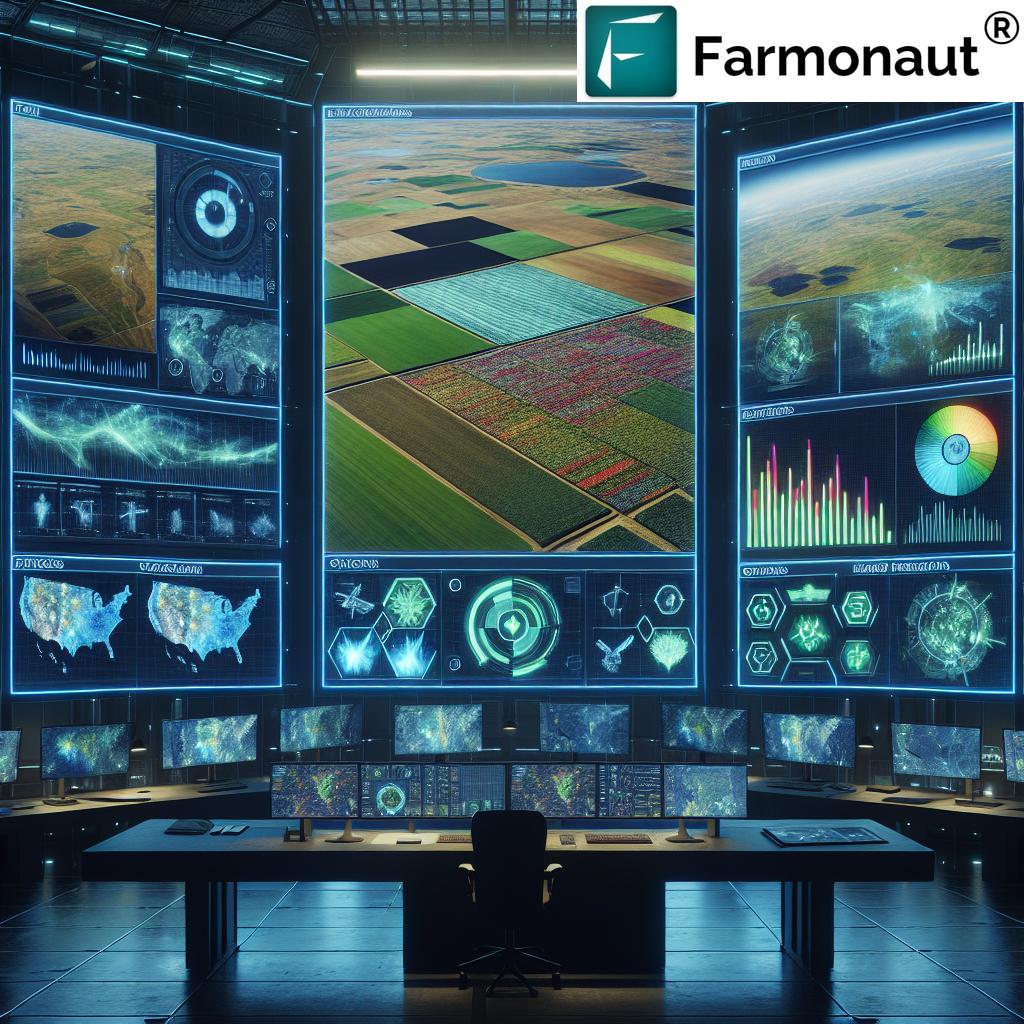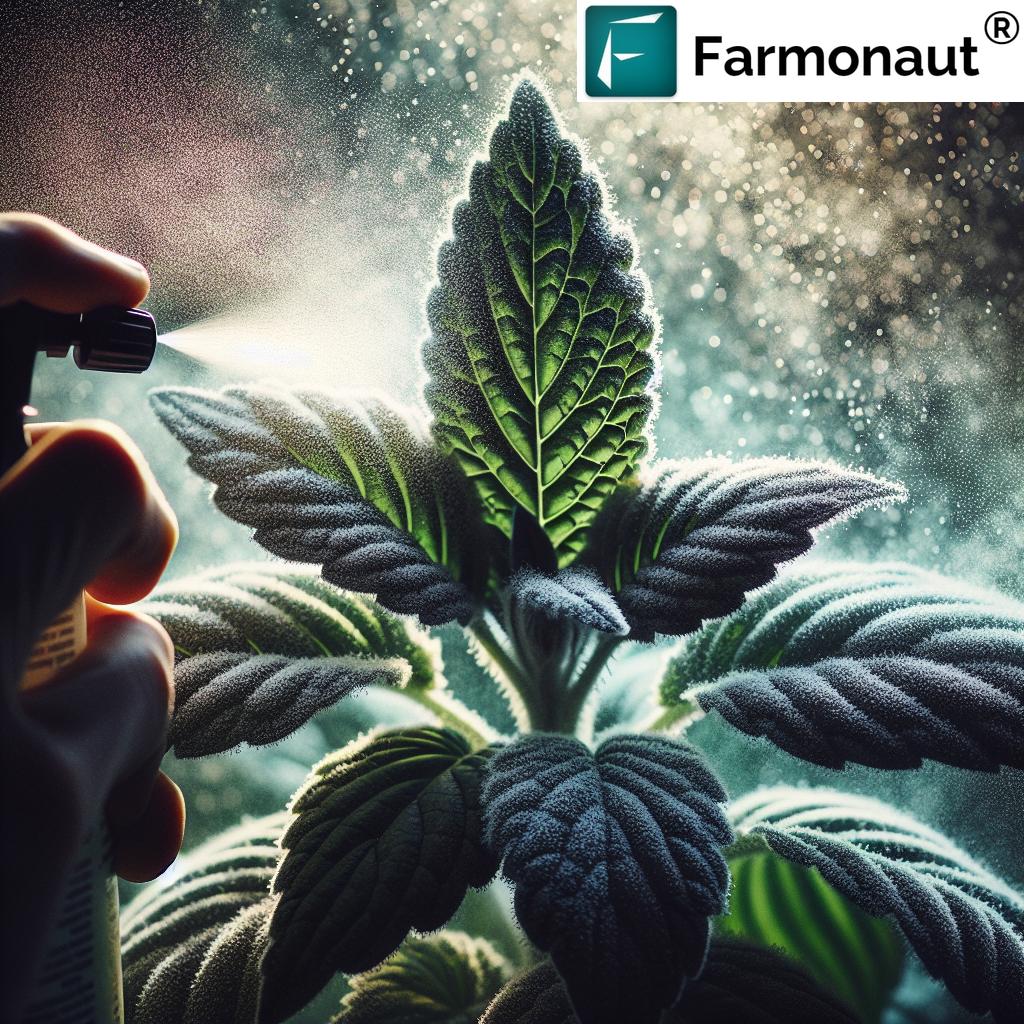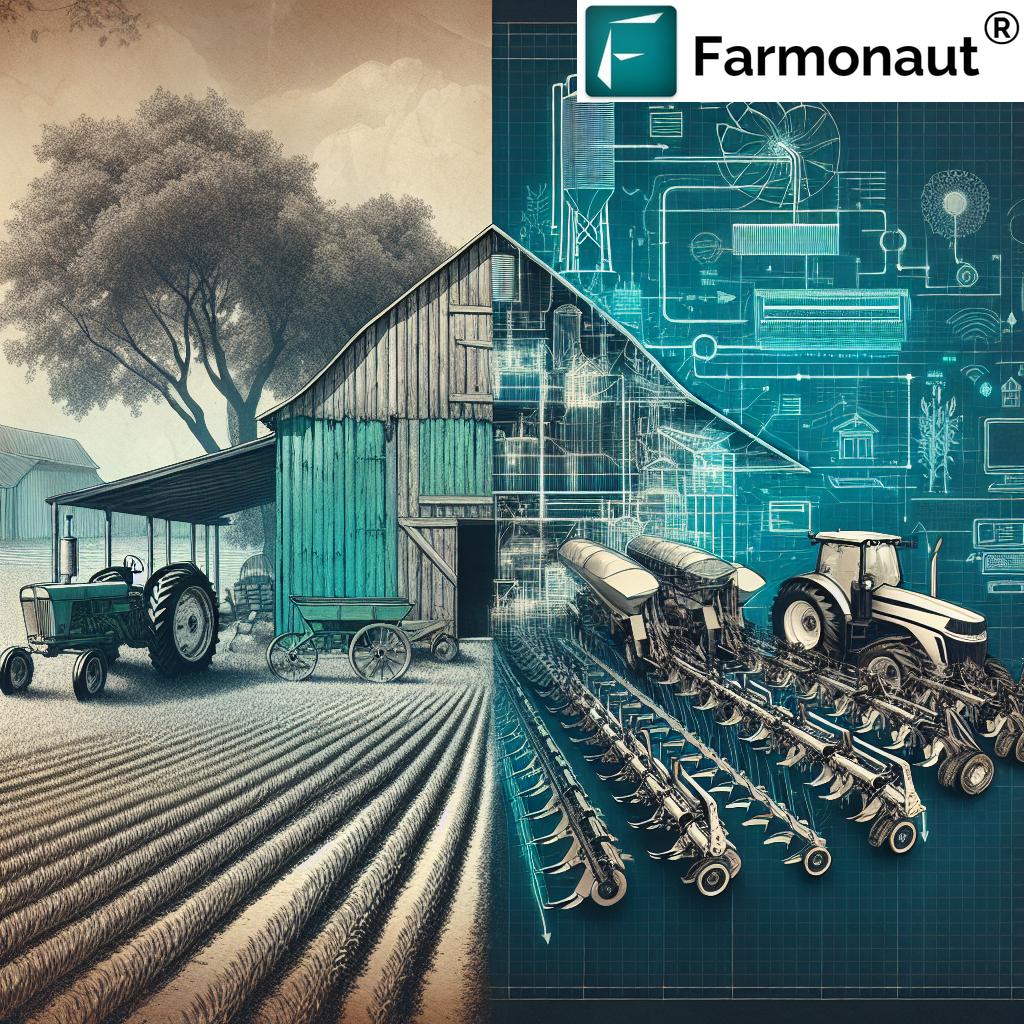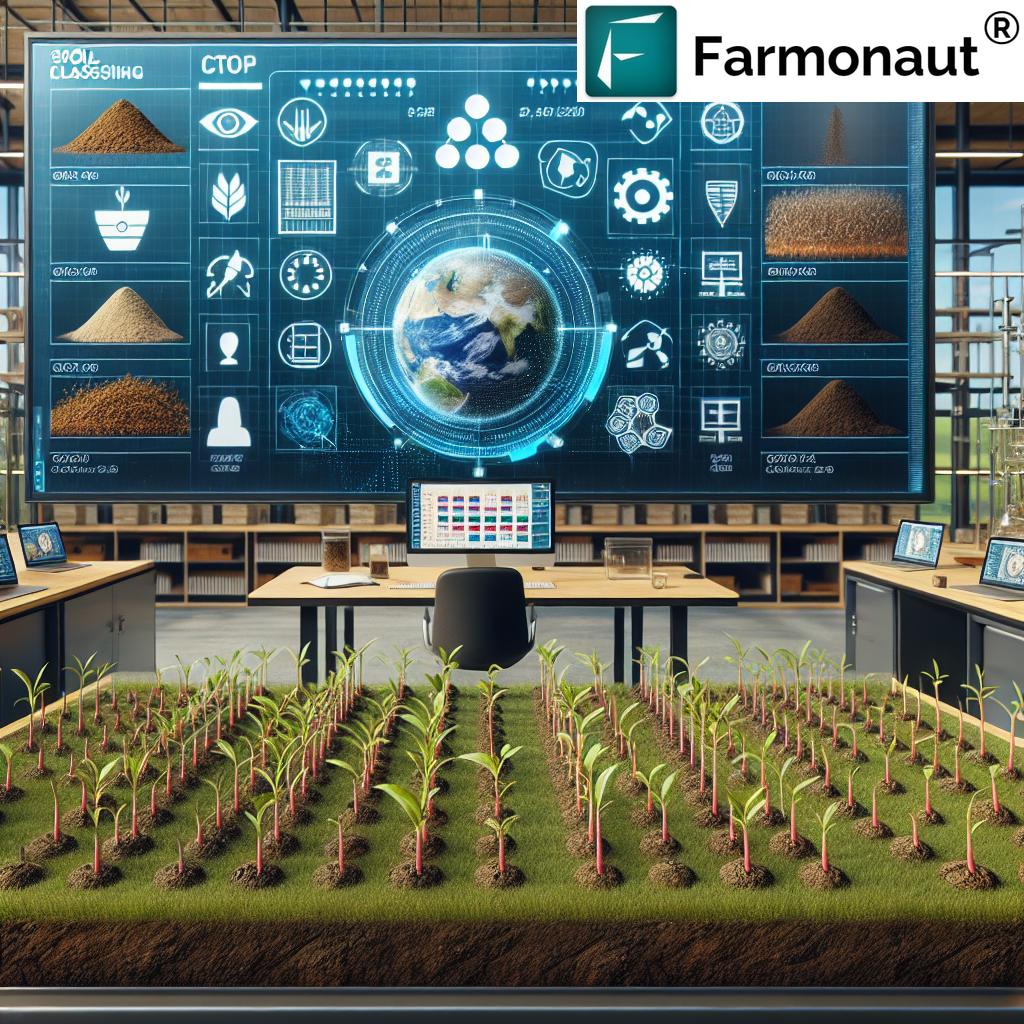Table of Contents
- Introduction: The Digital Transformation of Agriculture
- Understanding Digital Agriculture Platforms
- Key Components and Technologies Shaping Digital Agriculture
- Farmonaut: Pioneering Global Digital Adoption
- Major Benefits of Digital Agriculture Platforms
- Comparative Benefits Table: Traditional vs Digital Approaches
- Practical Examples: Global Digital Agriculture Platforms
- Key Challenges & Considerations in the Digital Shift
- The Future of Smart Farming
- Farmonaut Subscription Options
- Frequently Asked Questions (FAQ)
“AI-powered digital agriculture platforms can increase crop yields by up to 30% through precise data-driven decisions.”
Digital Agriculture Platform: Boost Farm Yields Fast!
In today’s fast-evolving world, digital agriculture platforms are at the heart of a technological revolution that is transforming how we manage farms, monitor crops, and ensure sustainable productivity. By integrating advanced AI, IoT, satellite imagery, and data analytics, these platforms empower farmers and agribusinesses to make informed, efficient, and environmentally conscious decisions.
As we journey through this comprehensive guide, let’s discover how digital agriculture is rewriting the rules of farming, making resource management smarter, reducing waste, and improving livelihoods worldwide. From soil health to market access, from disease detection to real-time crop monitoring tools, we’ll explore every major aspect of this digital transformation—highlighting the latest innovation and explaining why Farmonaut is pioneering this movement globally.
Understanding Digital Agriculture Platforms
To fully appreciate the impact of digital agriculture platforms, we must first understand what they are and the broad range of services and technologies they offer.
At their core, digital agriculture platforms serve as comprehensive systems that collect, analyze, and interpret data from various sources such as soil sensors, weather stations, satellite imagery, and more. These tools provide farmers with actionable insights, streamlining operations, supporting better decision-making processes, and empowering users to optimize their inputs for maximum yields and sustainability.
Digital agriculture platforms encompass a wide range of offerings:
- Crop health and growth monitoring
- Soil health and nutrient status tracking
- Pest and disease detection (using AI and IoT)
- Precise irrigation and fertilization schedules
- Resource management and input optimization
- Market access facilitation
- Real-time weather forecasting and climate resilience strategies
- Traceability for food safety and fair trade
Collectively, these functionalities enable informed decisions across all levels of agricultural and forestry management, dramatically enhancing productivity, profitability, and resilience.
“Over 70% of farmers using smart farming platforms report improved sustainability and resource efficiency.”
Key Components and Technologies Shaping Digital Agriculture
Modern digital agriculture platforms leverage a suite of advanced technologies—from AI in agriculture to IoT devices in farming—to provide a seamless, data-rich experience for users. Let’s explore the key components that set these platforms apart:
1. Artificial Intelligence (AI) and Machine Learning (ML)
- Predictive Analytics: AI-driven algorithms analyze vast amounts of agricultural data, delivering predictive models for disease outbreaks, optimal harvest times, and pest infestations.
- Proactive Measures: With these predictions, farmers can take preventive actions—reducing losses and maximizing crop yields.
- Weather Forecasting: Machine learning helps forecast weather patterns and soil conditions, aiding in timely planting schedules and irrigation management.
2. Internet of Things (IoT) Devices in Farming
- Real-Time Data Collection: Connected sensors track soil moisture, nutrient levels, temperature, and climate conditions.
- Precision Solutions: IoT data enables precise irrigation, targeted fertilization, and resource optimization, dramatically minimizing water and input waste.
For a detailed technical deep dive, discover the Farmonaut Satellite & Weather API and Developer Documentation—enabling seamless integration of digital data streams into your custom farm management systems.
3. Satellite Imagery Agriculture & Remote Sensing
- Comprehensive Crop Monitoring: Satellite-based imagery delivers high-resolution, multispectral data on crop health, soil moisture, and stress patterns across vast agricultural areas.
- Actionable Insights: These images not only support early detection of nutrient deficiencies and pest infestations but also guide irrigation, fertilizers, and harvest decisions.
4. Drones in Agriculture
- Multispectral Imaging: Drones equipped with sensors can rapidly scan fields, collecting real-time data on plant vitality, drought stress, and disease hotspots.
- Precision Application: These drones facilitate targeted application of inputs such as pesticides or fertilizers, minimizing environmental impact and saving costs.
5. Blockchain Traceability & Supply Chain Security
- Transparency: Blockchain ensures end-to-end product traceability, securing every transaction and transfer from the farm to the end buyer.
- Fair Trade & Trust: AI-backed digital logs prevent fraud, assure product origin, and open market access for farmers by connecting them directly to the supply chain.
6. Data-Driven Advisory and API Integration
Custom AI-powered advisory systems (like Farmonaut’s Jeevn AI) process satellite imagery agriculture data analytics, weather, and farm-specific details to recommend optimal practices, schedules, and input strategies for maximizing efficiency and yields.
Learn more about API-based data integration to supercharge your agribusiness at Farmonaut Developer Docs.
Farmonaut: Pioneering Global Digital Adoption
At the forefront of digital agriculture platforms, Farmonaut offers a unique blend of satellite imagery, artificial intelligence, blockchain traceability, and farm resource optimization—making precision agriculture affordable and accessible to farmers worldwide.
What sets Farmonaut apart is its focus on making advanced digital technology available not just to large agribusinesses, but to individual farmers, cooperatives, governments, and corporate clients. By leveraging AI-powered digital tools, Farmonaut democratizes access to:
- Real-time crop health monitoring—empowering rapid and informed decisions on irrigation, fertilization, and pest management.
- Blockchain-based traceability—enhancing product security and supply chain transparency.
- Jeevn AI personalized advisory—analyzing data from satellite imagery, weather, and on-field reports to suggest actionable measures for sustainability and efficiency.
- Carbon footprint tracking—enabling farmers and agribusinesses to monitor and reduce their environmental impact.
- Satellite-based crop verification for financing—expanding access to crop loans and insurance with trusted, data-backed verification.
- Fleet and resource management tools—optimizing agricultural operations beyond the farm field.
Major Benefits of Digital Agriculture Platforms
Digital innovation in agriculture unlocks a new era of efficiency, sustainability, and productivity for farmers around the world. Let’s examine the most significant advantages these platforms deliver:
1. Enhanced Decision-Making Through Data Analytics
- Real-time data from satellites, IoT sensors, and weather feeds enables fact-based decisions—empowering farmers to optimize every step from planting schedules to harvest times.
- By leveraging AI in agriculture, these platforms elevate traditional practices by predicting outcomes and recommending proactive measures.
2. Maximizing Resource Efficiency & Reducing Input Wastage
- Digital solutions like precision farming technologies direct water, fertilizers, and pesticides only where needed, saving resources and minimizing environmental impact.
- Farmonaut’s app lets users track soil moisture, weather, and plant health in minutes—significantly reducing wasted resources.
For large-scale applications, check the Agro Admin App for plantation and large-scale farm management.
3. Sustainability and Environmental Impact
- By monitoring carbon footprint and supporting regenerative agricultural practices, digital platforms help combat climate change and protect soil health.
- AI-driven reporting tools provide measurable proof of carbon reduction for compliance and marketing.
Explore Farmonaut’s Carbon Footprinting Service for advanced sustainability tracking and reporting.
4. Market Access & Supply Chain Efficiency
- Many digital agriculture platforms streamline market access for farmers by linking them directly to buyers, ensuring fair pricing and transparent trade channels.
- Digital traceability reduces fraud and assures buyers about product origin and quality.
Dive deeper into Farmonaut’s Blockchain Product Traceability to see how robust supply chain transparency is built.
5. Smart Monitoring and Reduced Crop Losses
- Crop monitoring tools and digital disease detectors spot problems before they escalate, cutting losses from pests, disease, or drought by enabling timely interventions.
- Using satellite imagery agriculture, you can scout large areas in seconds, identifying stress zones invisible to the naked eye.
6. Greater Access to Financing and Insurance
- Satellite-based verification simplifies access to loans and insurance, especially for smallholder farmers, by providing trusted digital evidence of farm activities and productivity.
See how Farmonaut’s Crop Loan & Insurance Service transforms agricultural financing.
Comparative Benefits Table: Traditional vs. Digital Agriculture Practices
To illustrate the impact of digital agriculture platforms, here is a comparative table showcasing their advancements over traditional agricultural methods.
| Criteria | Traditional Agriculture | Digital Agriculture Platforms |
|---|---|---|
| Yield Increase | Up to 10% (Contextual, reactive) | Up to 30% (Predictive, data-driven decisions) |
| Resource Efficiency | Manual; Can lead to >30% input wastage | Optimized; as low as 10% input wastage with IoT and AI |
| Real-Time Monitoring | Periodic scouting; Delayed response to stress | Continuous, real-time data from sensors, satellites, & drones |
| Sustainability Impact | Limited; Excessive use of fertilizers/pesticides | Supports regenerative and climate-smart agriculture |
| Pest & Disease Detection | Reactive; after visual damage or outbreaks | AI-enabled early detection and predictive prevention |
| Market Access & Traceability | Often indirect; lack of transparent pricing | Blockchain-backed; direct market access & fair trade |
| Financing & Insurance Access | Lengthy, manual verification; higher risk of fraud | Satellite-based instant verification; secure for lenders |
Practical Examples: Global Digital Agriculture Platforms
Let’s highlight some prominent digital agriculture platforms across global markets:
- eNAM (National Agriculture Market–India): Digital marketplace integrating over 1,000 markets across 18 states, supporting market access and fair trade for farmers.
- DeHaat (India): End-to-end agricultural services offering crop advisory, inputs, financial services, and full supply chain support for hundreds of thousands of smallholder farmers.
- DigiFarm (Kenya): Provides digital extension services, satellite-based soil testing, insurance, and market linkages to enhance food security and income for smallholders in Africa.
Across every continent, digital agriculture platforms like Farmonaut are building resilient systems connecting farmers to markets, buyers, and cutting-edge technology—helping to ensure global food supply and sustainability.
Key Challenges & Considerations in the Digital Shift
Despite their promise, digital agriculture platforms also face several challenges that must be tackled to ensure wide-scale and equitable adoption:
- Digital Literacy: Many farmers, especially in rural or remote areas, may not be familiar with advanced digital tools, requiring effective training and support programs.
- Infrastructure Limitations: Reliable internet access and power supply remain barriers to adoption in developing regions.
- Cost Concerns: Initial investment in devices and platforms can be significant for smallholder farmers, although affordable options like Farmonaut are making digital solutions more accessible.
- Privacy & Data Security: As more agricultural process data is digitized, robust security measures are essential to protect farmer privacy and prevent misuse.
- Interoperability: Integrating diverse hardware and software—especially across languages and geographies—needs open standards and responsive API solutions.
Farmonaut addresses many of these concerns through a user-friendly mobile app (supported on Android and iOS), low-barrier-to-entry subscription options, and a high level of data security and interoperability. The platform is equally effective for individual smallholder farmers, large agribusinesses, and government-scale projects.
The Future of Smart Farming: Integrating Digital Platforms for All
The journey towards fully-digitized, climate-smart, and sustainable agriculture is just beginning. Over the next decade, we will see:
- More Sophisticated AI and Machine Learning, providing personalized crop recommendations, yield predictions, and real-time response automation.
- Expanding IoT Networks of affordable, robust sensors—turning every field into a connected, data-rich environment.
- Expanded Market Access for Farmers through digital trading platforms, supporting fair pricing and food safety traceability.
- Broader Adoption of Satellite Imagery Agriculture, making crop monitoring tools affordable for the smallest and largest growers alike.
- Increased Support for Regenerative Agriculture and Carbon Tracking—ensuring agriculture not only feeds the world but protects it.
As global pressure grows to produce more food with less environmental impact, digital agriculture platforms like Farmonaut will be crucial allies. By seamlessly integrating technologies and democratizing data, these platforms equip every farmer, cooperative, and agribusiness for resilient, efficient, and climate-smart farming.
Farmonaut Subscription Options
Ready to take your farm to the next level? Farmonaut offers flexible, affordable subscriptions for individuals, cooperatives, agribusinesses, and government projects. Choose the solution that fits your operation and start leveraging powerful digital technology for precision and productivity today!
Frequently Asked Questions (FAQ)
1. What is a digital agriculture platform?
A digital agriculture platform is a comprehensive system integrating technologies such as AI, IoT, satellite imagery, and data analytics to automate and optimize various farming processes. These platforms help farmers monitor crops, manage resources, access market information, and ensure sustainability.
2. How does AI in agriculture increase farm yields?
AI-powered algorithms analyze massive amounts of agriculture data to detect patterns, predict disease outbreaks, and recommend precise practices (e.g., optimal planting or irrigation schedules). This enables proactive, informed decisions that can boost yields by as much as 30%.
3. Why are IoT devices critical for modern farming?
IoT devices collect real-time data on soil moisture, nutrient levels, weather, and crop health. This allows for targeted water and fertilizer application, reduces waste, and quickly alerts farmers to potential problems—making farming both more efficient and sustainable.
4. Can digital platforms help smallholder farmers?
Yes! Digital agriculture platforms like Farmonaut are specifically designed to be affordable and user-friendly for smallholders. Services such as satellite-based monitoring and AI advisories are accessible via mobile app—even at small field and resource scales.
5. Is my farm data secure on digital platforms?
Data security is a top priority for reputable platforms. Farmonaut uses encrypted systems and blockchain protocols to ensure confidentiality, transparency, and protection from unauthorized access or fraud.
6. How do I get started with Farmonaut?
Simply download the web, Android, or iOS app using the buttons above, or visit the web portal. Choose a subscription plan suited to your needs and start leveraging digital technolgy for smarter farming.
For large-scale management, check out the Agro Admin App.
7. Can I integrate Farmonaut’s data into my own applications?
Absolutely! Farmonaut offers robust API access for developers and businesses. Start building your own agriculture tools and get full documentation at the Developer Docs.
8. How does digital agriculture support sustainability?
By enabling precision farming, reducing input wastage, and providing carbon footprinting data, digital platforms directly contribute to more sustainable, climate-friendly food production systems.
Conclusion
The digital agriculture platform revolution is here. By integrating AI, IoT, satellite imagery, and actionable insights, we can boost farm yields fast, streamline operations, and protect environmental resources for generations to come. Farmonaut stands as a leading example, making affordable precision agriculture a reality for the global farming community.
Ready to go digital?
Start your journey with Farmonaut—accessible anywhere, for any farm, anytime.







